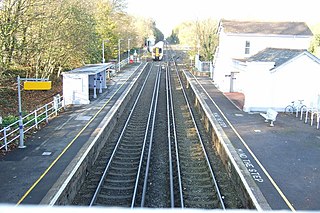In telecommunications and professional audio, a balanced line or balanced signal pair is a transmission line consisting of two conductors of the same type, each of which have equal impedances along their lengths and equal impedances to ground and to other circuits. The chief advantage of the balanced line format is good rejection of external noise when fed to a differential amplifier. Common forms of balanced line are twin-lead, used for radio frequency signals and twisted pair, used for lower frequencies. They are to be contrasted to unbalanced lines, such as coaxial cable, which is designed to have its return conductor connected to ground, or circuits whose return conductor actually is ground. Balanced and unbalanced circuits can be interconnected using a transformer called a balun.
In telecommunication, the term common-mode interference has the following meanings:
- Interference that appears on both signal leads, or the terminals of a measuring circuit, and ground.
- A form of coherent interference that affects two or more elements of a network in a similar manner as distinct from locally generated noise or interference that is statistically independent between pairs of network elements.

Twin-lead cable is a two-conductor flat cable used as a balanced transmission line to carry radio frequency (RF) signals. It is constructed of two stranded copper or copper-clad steel wires, held a precise distance apart by a plastic ribbon. The uniform spacing of the wires is the key to the cable's function as a transmission line; any abrupt changes in spacing would reflect some of the signal back toward the source. The plastic also covers and insulates the wires.

In radio and telecommunications a dipole antenna or doublet is the simplest and most widely used class of antenna. The dipole is any one of a class of antennas producing a radiation pattern approximating that of an elementary electric dipole with a radiating structure supporting a line current so energized that the current has only one node at each end. A dipole antenna commonly consists of two identical conductive elements such as metal wires or rods. The driving current from the transmitter is applied, or for receiving antennas the output signal to the receiver is taken, between the two halves of the antenna. Each side of the feedline to the transmitter or receiver is connected to one of the conductors. This contrasts with a monopole antenna, which consists of a single rod or conductor with one side of the feedline connected to it, and the other side connected to some type of ground. A common example of a dipole is the "rabbit ears" television antenna found on broadcast television sets.

Antenna tuner, matchbox, transmatch, antenna tuning unit (ATU), antenna coupler, and feedline coupler are all equivalent names for a device connected between a radio and its antenna to improve power transfer between them by matching the specified load impedance of the radio to the combined input impedance of the feedline.

Spelt, also known as dinkel wheat or hulled wheat, is a species of wheat cultivated since approximately 5000 BC.

Shepherds Well railway station is on the Dover branch of the Chatham Main Line in England, and serves the village of Shepherdswell, Kent. It is 71 miles 60 chains (115.5 km) down the line from London Victoria and is situated between Snowdown and Kearsney.

Dalhousie cantonment is a town in Chamba district in the state of Himachal Pradesh, India.

Hellens Manor, also known as Hellens House or simply Hellens and located in the village of Much Marcle in Herefordshire is one of the oldest dwellings in England, primarily composed of Tudor, Jacobean, and Georgian architecture, but the foundations date from the 12th century, with some elements older still.

Hazelwood Railway Station is a disused railway station on the Wirksworth branch of the Midland Railway. It served the village of Hazelwood. The line has been reopened in stages as the Ecclesbourne Valley Railway.
Dunnamore is a village and townland in County Tyrone, Northern Ireland. It is near the main A505 road between Omagh and Cookstown. It is Part of Cookstown District Council There is a stone circle within two miles of the village centre.

A sheath current is a form of charge transfer in wires. Sheath currents can run along the outer sheath of a coaxial cable. This can be caused by a geographically proximate or remote ground potential.
Charlie Richard Balun was an American writer and film critic for several horror magazines including Fangoria and Gorezone. He died in California of cancer on December 18, 2009, aged 61.
John de Baalun or Balun, was a justice itinerant and baron.
Sonja Balun Harand is an Austrian former figure skater who competed in ladies' singles. She is a four-time Austrian national champion (1973–1976) and competed at the 1972 Winter Olympics, finishing 17th.

The G5RV antenna is a dipole with a symmetric resonant feeder line, which serves as impedance matcher for a 50 ohm coax cable to the transceiver.
Tanjong Malim is a federal constituency in Perak, Malaysia, that has been represented in the Dewan Rakyat since 1959.
Soňa (Sonja) Balunová, née Buriánová was a Czechoslovak pair skater. With Miloslav Balun, she became the 1954 European bronze medalist and a six-time national champion. She also competed in volleyball and athletics.
This page is based on this
Wikipedia article Text is available under the
CC BY-SA 4.0 license; additional terms may apply.
Images, videos and audio are available under their respective licenses.













